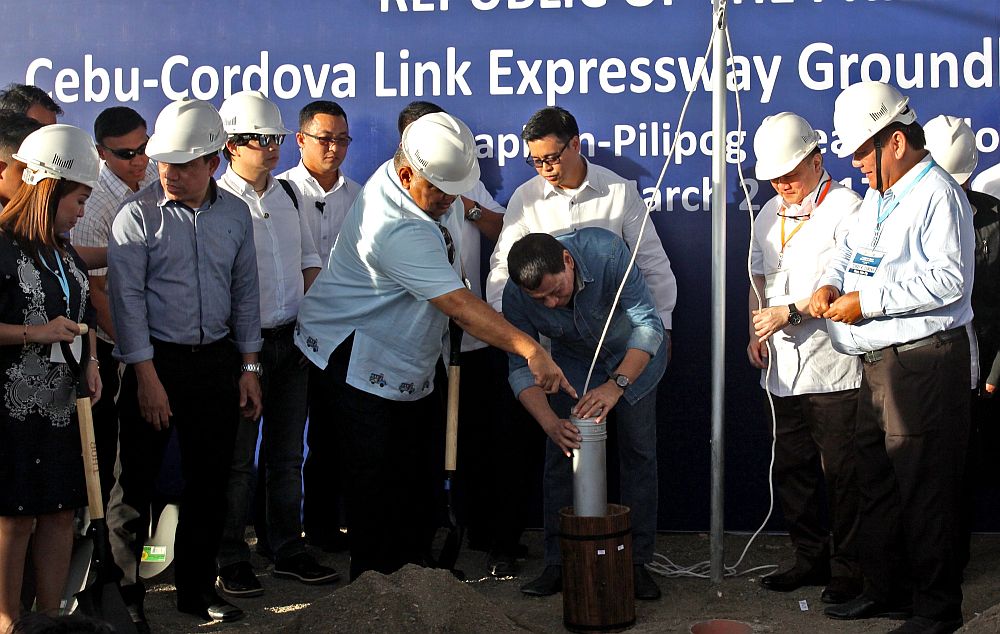
President Rodrigo Duterte (5th from left) lowers the time capsule during March 2, 2017’s groundbreaking of the Cebu-Cordova bridge in Sitio Dapitan, Barangay Pilipog, Cordova Cebu. The bridge is among the anticipated infrastructure projects in Cebu.
CDN FILE PHOTO
Real estate is poised to become the “next big thing” in the Philippines as the government undertakes a massive infrastructure program until 2022, which is foreseen to create thousands of jobs and spur economic activity.
Anthony Gerard Leuterio, owner and founder of Leuterio Realty and Brokerage, Inc., said that if the government is really serious in pursuing its plan to “build, build, build,” then prospects are bright for the property sector.
“These projects will create more jobs, and more jobs will create real estate activity. If you have a job, you will have the capacity to buy a house. When spending is high, many will buy houses of their own,” Leuterio told Cebu Daily News in an interview.
Leuterio said that even if the government’s big-ticket infrastructure projects only generate 10,000 jobs in the next six years, with 50 percent of those employed still without houses, the demand would still be significant.
He said that the real estate’s multiplier effect extends to at least 60 industries, providing growth to many sectors outside the industry.
Among the projects that many Cebuanos are excited about are the new airport terminal set to be operational by June 2018, the Cebu-Cordova bridge, the new Cebu International Port in Consolacion, as well as transport projects, including an expressway connecting Naga City in the south to Danao City in the north.
Leuterio said all these projects would increase economic activity in Cebu, which would eventually lead to a surge in the market value of properties here.
Property value
He said that based on his study, a property appreciates in value faster when it is located in a business district or a booming city.
“Economic activity increases value. The more offices, hospitals, businesses are around a project, the higher the value,” he explained.
He said four years ago, properties at the Cebu IT Park cost from P30,000 to P50,000 per square meter, but, today, prices are pegged at around P200,000 per square meter mainly because of the entry of more call centers, offices, and other establishments.
Along the busy Osmeña Boulevard (formerly Jones Avenue), the value of properties was pegged at P70,000 to P80,000 per sq. m. 10 years ago, but this has since grown to more than P150,000 per sq. m. today, owing to developments and improvements on infrastructure in the area.
Rental, tourism
Aside from the location, the demand for rental spaces will also contribute to the appreciation, Leuterio said.
What makes Cebu City a good place to develop a project is that many people from other provinces have come here to work, increasing its population and also jacking up the demand for housing.
Other factors like tourism also contribute to the increase of a property’s market value, Leuterio added, citing as examples Bohol, Dumaguete, and Bacolod as among those enjoying steady growth in real estate due to tourism.
Terminal, bridge
Terminal 2 of the MCIA is set to upgrade the gateway’s capacity to 12.5 million by next year from the current 4.5 million. The new bridge, meanwhile, is expected to cut travel time from mainland Cebu to Mactan Island via Cordova town.
“As for us in Cordova, we will be closer to the city. We don’t have to pass by Lapu-Lapu City and Mandaue City. The people will also have more opportunities to work in the city. In addition, it will be a gateway for us to have an increased influx of people especially in our tourist destinations. Cordova will be brought closer,” Cordova Mayor Theresa “Tetche” Sitoy-Cho said in a previous interview.
These upcoming infrastructure developments are foreseen to shape the real estate industry as players take advantage of the opportunities brought about by Cebu’s booming economy.
Needed catalyst
Franco Soberano, chief operating officer of publicly-listed homegrown developer Cebu Landmasters, Inc. (CLI), said there is no better time for the government’s “build, build, build” program but now.
“To sustain growth in the Visayas and Mindanao, this is the needed catalyst,” he said.
Soberano added that the program would allow them to align their plans so that future developments could integrate well with the new infrastructure buildup.
He added that the initiative would bring about better connectivity of public and private efforts as well as better standards of living, and sustainability.
“We look forward to this infrastructure push and sincerely hope the timelines are achieved,” said Soberano.